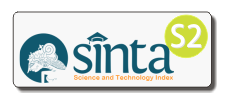RCA Analysis With Selected Product: Modified Approach Applied to Indonesian Export
Abstract
Keywords
Full Text:
PDFReferences
Aslam, M. (2018). ASEAN-China FTA and the Impact on Indonesian Manufacturing Industry. JATI-Journal of Southeast Asian Sudies, 23 (1), 13-46.
Baldwin, R.E. (2008). Managing the Noodle Bowl: the Fragility of East Asian Regionalism. The Singapore Economic Review, 53 (3), 449 – 478.
Ballance, R. H., Forstner, H. & Murray, T. (1987). Consistency tests of alternative measures of comparative advantage. Review of Economics & Statistics, 69, 157-161.
Coniglio, N.D., Vurchio, D., Cantore, N. & Clara, M. (2018). On the evolution of comparative advantage: path dependent versus path-defying changes. Southern European Research in Economic Studies, Series Working Paper No. 01/2018.
Costinot, A., Donaldson, D. & Komunjer, I. (2012). What Goods Do Countries Trade ? A Quantitative Exploration of Ricardo’s Ideas. Review of Economic Studies, 79 (5), 581-608.
Crawford, J-A. & Fieorentino, R.V. (2005). The Changing Landscape of Regional Trade Agreement. WTO Discussion Paper No. 8.
Crowley. A.M. (2003). An Introduction to the WTO and GATT. Economic Perspectives, 27 (4), 42 -57.
DFAT-Australia (Department of Foreign Affairs and Trade, Australian Goverment) (2003). China's Industrial Rise- East Asia's Challenge (https://dfat.gov.au/about-us/publications/trade-investment/chinas-rise/Pages/china-s-industrial-rise-east-asia-s-challenge. aspx).
Eaton, J. & Kortum, S. (2002). Technology, Geography, and Trade. Econometrica 70 (5), 1741 – 1779.
Gnidchenko, A.A. & Salnikov, V. (2015). Net Comparative Advantage Index: Overcoming the Drawbacks of the Existing Indices. HSE Working Papers WP BRP 119/EC/2015. National Research University Higher School of Economics.
Howse, R. (2016). The World Trade Organization 20 Years On: Global Governance by Judiciary. The European Journal of International Law, 27 (1), 9 – 77.
Kawai, M. & Wignaraja, G. (2014). Trade Policy and Growth in Asia. ADBI Working Papers Series No. 495.
Kresnowati, A.M., Ananda, C.F. & Khusaini, M. (2016). Role of Manufacturing Sector and Trade, Hotel, Restaurant Sector in East Java’s Economy: Input Output Analysis. Jurnal Ekonomi dan Studi Pembangunan, 8(2), 168-181.
Krugman P.R., Obstfeld, M. & Melitz, M.J. (2012). International Economics: Theory and Policy 9th edition (Boston etc.: Addison-Weley) pp 80-96.
Leromain, E. & Orefice, G. (2014). New Revealed Comparative Advantage Index: Dataset and Empirical Distribution. International Economics, 139 (1), 48 – 70.
Martijn, J.K. & Tsangarides, C.G. (2007). Trade Reform in CEMAC: Development and Opportunities. IMF Working Paper, WP/07/137.
Nguyen, T.N.A., Pham, T.H.H. & Vallee, T. (2017). Similarity in trade structure: evidence from ASEAN + 3. The Journal of International Trade and Economic Development – An International and Comparative Review, 26 (8), 1000 -1024.
Okabe, M. (2015). The Impact of ASEAN+1 FTAs on ASEAN’s Trade in Ing, L.Y. (ed.): East Asian Integration. ERIA Research Project Report 2014-6, Jakarta: Eria, pp. 27-66.
Riandi, R. & Pratomo, Y. (2017). Indonesian Comparative Advantage Entering The ASEAN Economic Community. Jurnal Ekonomi dan Studi Pembangunan, 9(1), 87-102.
Salvatore, D. (2013). International Economics 11th edition (Hoboken NJ: John Wiley & Sons) pp 109-127.
Sanidas, E. & Shin, Y. (2010). Comparison of revealed comparative advantage indices with application to trade tendencies of East Asian Countries. Department of Economics, Seoul National University (http://www.akes.or.kr/eng/papers(2010)/24.full.pdf).
Saqib, M., Irshad & Xin, Q. (2017). Determinants of Exports’ Competitiveness: An Empirical Analysis Through Revealed Comparative Advantage of External Sector of Pakistan. Asian Economic and Finance Review, 7 (6), 623 – 633.
Setyastuti, R., Adiningsih, S. & Widodo, T. (2018). The Dynamics of Comparative Advantage in the ASEAN Region. MPRA Paper No. 86541 (https://mpra.ub.uni-muenchen.de/86541/).
Shujiro, V. & Misa, O. (2007). The Impact of Free Trade Agreements on Trade Flows: An Application of the Gravity Model Approach. RIETI Discussion Paper Series )7-E-052. The Research Institute of Economy, Trade and Industry (http: www.rieti.go.jp/en/).
Tampubolon, J. (2019). Indonesian Export Performance and Competitiveness in the ASEAN-China FTA. WSEAS Transaction on Business and Economics, 16, 120-129.
World Bank (2012). Export Competitiveness in Indonesia’s Manufacturing Sector. Policy Note 2, The World Bank Office Jakarta.
Yeats, A. (1985). On the appropriate interpretation of the revealed comparative advantage index: implications of a methodology based on industry sector analysis. Weltwirtschaftliches Archiv, 121, 61-73.
Yihong, T. & Weiwei, W. (2006). An Analysis of Trade Potential between China and ASEAN within China-ASEAN FTA. International Conference on WTO, China and the ASEAN Economies, IV: Economic Integration and Economic Development, University of International Business and Economics, Beijing, China, June 24-25, 2006.
DOI: http://dx.doi.org/10.17977/um002v11i22019p143
Refbacks
- There are currently no refbacks.
ISSN (Print) 2086-1575 ISSN (Online) 2502-7115

This work is licensed under a Creative Commons Attribution-NoDerivatives 4.0 International License.







